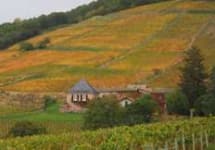Pavillon de Chavannes Cote de Brouilly Cuvee des Ambassades 2020



Product Details
Your Rating
Somm Note
Winemaker Notes
This is a very old school Beaujolais in the best sense: beautiful garnet color, beguiling aromatics, and a burst of refreshment in the mouth—and that burst is a savory, mineral, toothsome thing because of the domain’s high elevations and because of Mont Brouilly’s blue granite. Some crus emphasize soil notes, others give fruit, but only good Côte de Brouilly gives stone in the flavor.
Other Vintages
2018-
Robert
Parker
-
Robert
Parker
-
Robert
Parker


The Lafond family whose head was a peer of the French realm and the adminsitrator of the Bank of France sold Chavannes to Pierre Jambon Chanrion in 1861 and it is his grandchildren who still run the vineyard. The Jambon family has often distinguished itself in winemaking since that time, most notably in the improvements its members made the Gamay grape of Burgundy and their perfecting of the techiniques for supporting growing vines on steep slopes.
The vines grow on blue granite soil, well exposed to sunlight over an area of a little over 40 acres. The type of vine is naturally the clear juiced Burgundy or Gamay black grape. Harvesting is manual, all impurities being removed (soil, leaves, unripe grapes). The winemaking process is carefully managed, fermentation temprature being monitored and pressing progremmed. The wine is matured in oak casks.

Delightfully playful, but also capable of impressive gravitas, Gamay is responsible for juicy, berry-packed wines. From Beaujolais, Gamay generally has three classes: Beaujolais Nouveau, a decidedly young, fruit-driven wine, Beaujolais Villages and Cru Beaujolais. The Villages and Crus are highly ranked grape growing communes whose wines are capable of improving with age whereas Nouveau, released two months after harvest, is intended for immediate consumption. Somm Secret—The ten different Crus have their own distinct personalities—Fleurie is delicate and floral, Côte de Brouilly is concentrated and elegant and Morgon is structured and age-worthy.

The bucolic region often identified as the southern part of Burgundy, Beaujolais actually doesn’t have a whole lot in common with the rest of the region in terms of climate, soil types and grape varieties. Beaujolais achieves its own identity with variations on style of one grape, Gamay.
Gamay was actually grown throughout all of Burgundy until 1395 when the Duke of Burgundy banished it south, making room for Pinot Noir to inhabit all of the “superior” hillsides of Burgundy proper. This was good news for Gamay as it produces a much better wine in the granitic soils of Beaujolais, compared with the limestone escarpments of the Côte d’Or.
Four styles of Beaujolais wines exist. The simplest, and one that has regrettably given the region a subpar reputation, is Beaujolais Nouveau. This is the Beaujolais wine that is made using carbonic maceration (a quick fermentation that results in sweet aromas) and is released on the third Thursday of November in the same year as harvest. It's meant to drink young and is flirty, fruity and fun. The rest of Beaujolais is where the serious wines are found. Aside from the wines simply labelled, Beaujolais, there are the Beaujolais-Villages wines, which must come from the hilly northern part of the region, and offer reasonable values with some gems among them. The superior sections are the cru vineyards coming from ten distinct communes: St-Amour, Juliénas, Chénas, Moulin-à-Vent, Fleurie, Chiroubles, Morgon, Regnié, Brouilly, and Côte de Brouilly. Any cru Beajolais will have its commune name prominent on the label.
